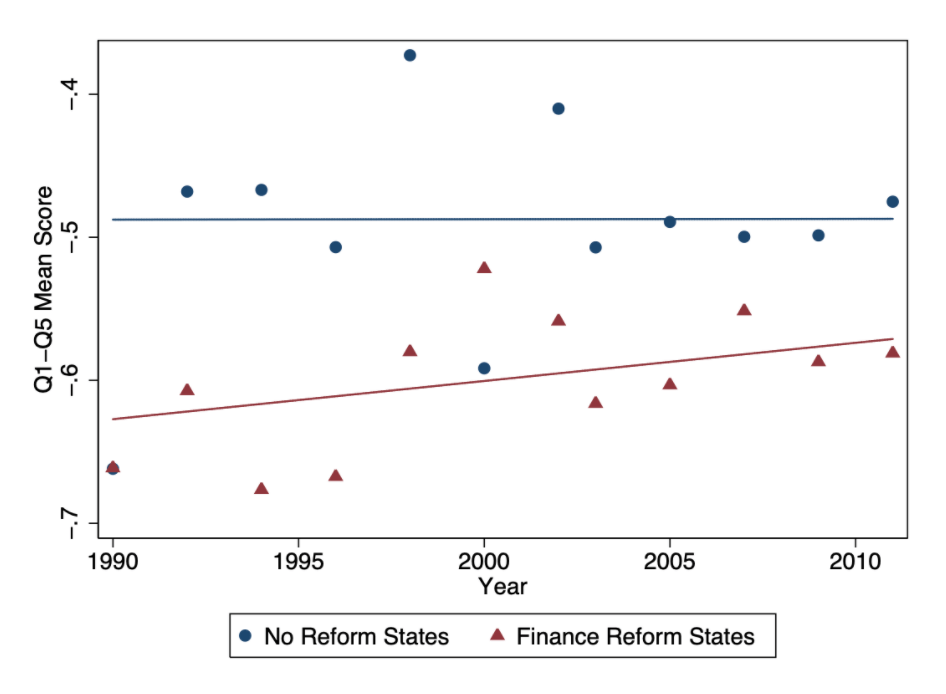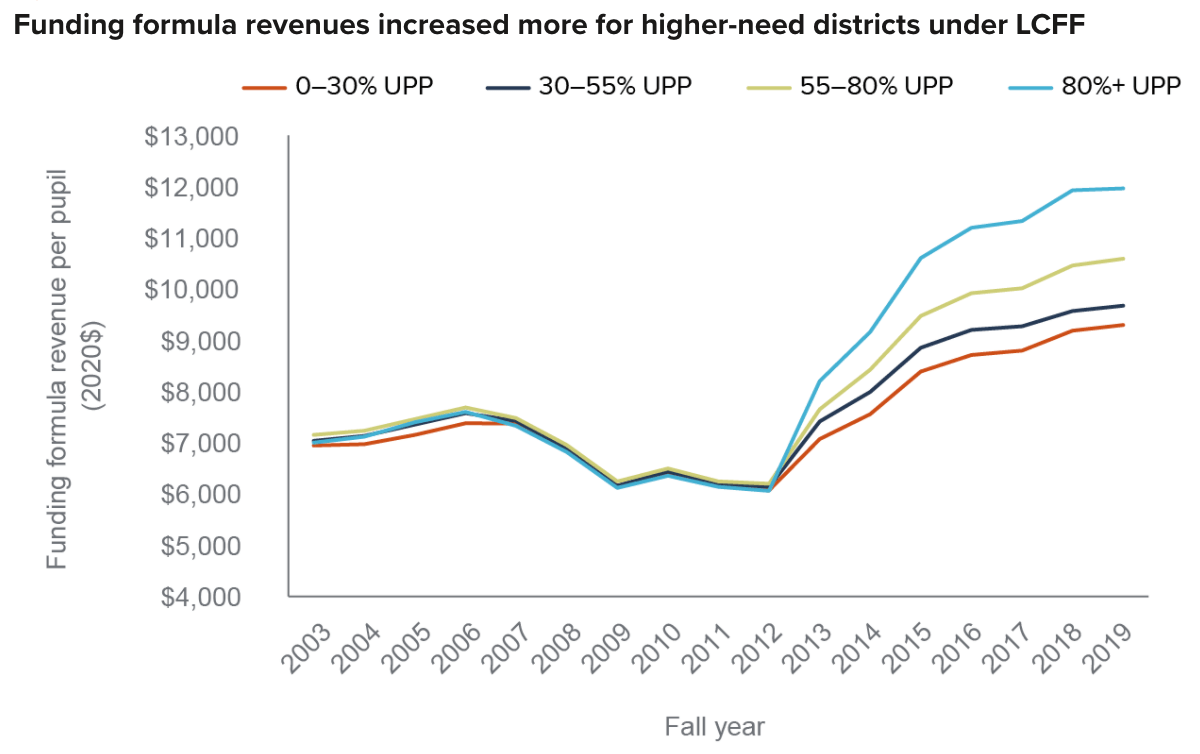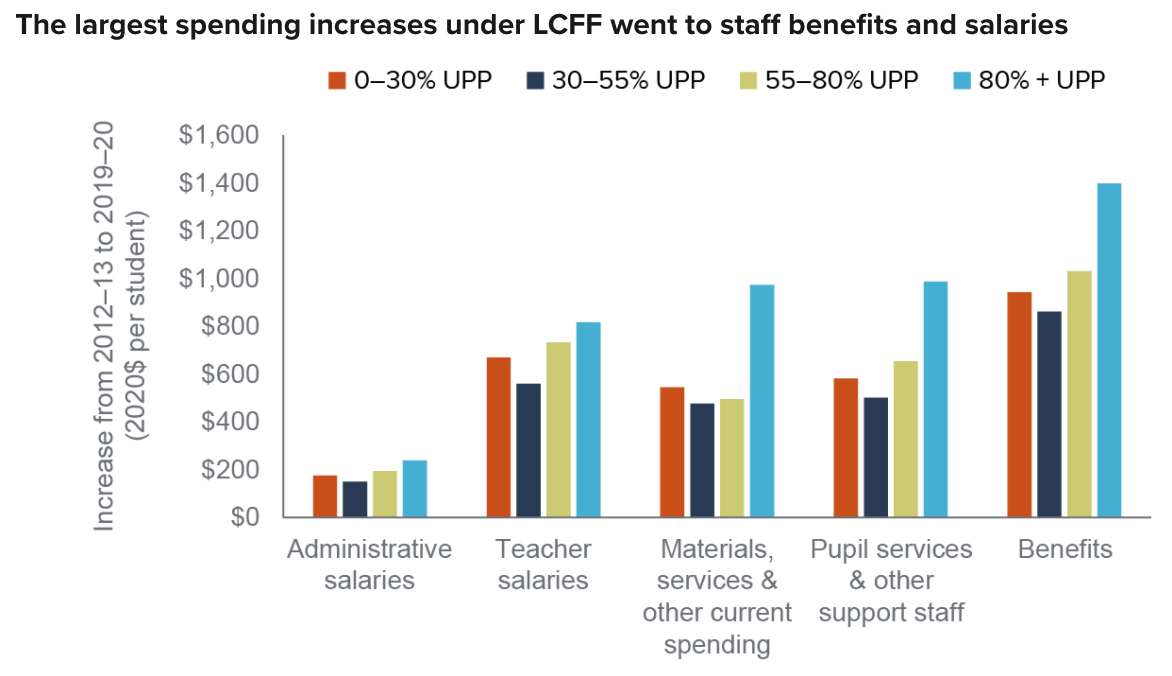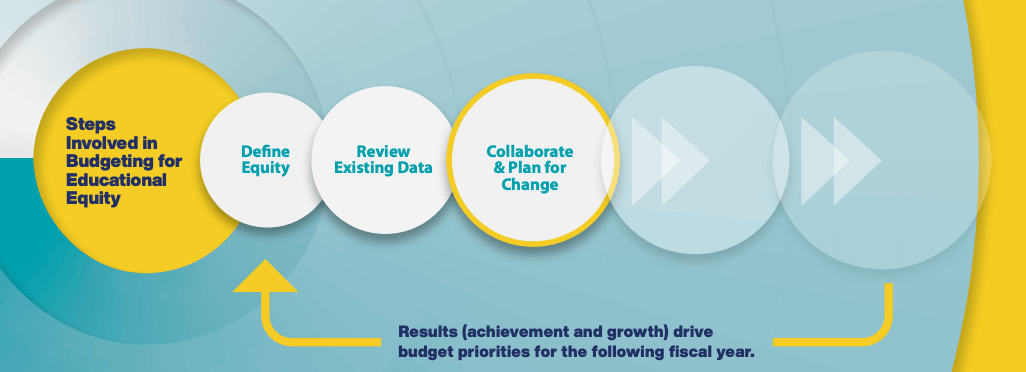Budgeting for Educational Equity

LCFF improves equity
Over the last decade, many states and school districts have changed the way that schools are funded. Some of these changes have been designed in the pursuit of education equity. That is, they shore up funding for schools in a way that intentionally delivers more funds to places that have less.
 Guest Comment
Guest CommentJohn Diaz
In California, this approach is central to the Local Control Funding Formula (LCFF), the state’s core education finance law. Enough time has now passed to take stock of this strategy. Which approaches have shown the most promise?
A trio of scholars examined the evidence in a 2016 working paper organized through the National Bureau of Economic Research. They found that school finance reforms based on sharp, immediate, and sustained increases in targeted spending in low-income school districts can cause gradual increases in student achievement in math and reading in the years that follow the initial investment. Targeted revenue increases to school districts with high concentrations of students from low income families are key.
Other research has corroborated this conclusion. Most research has found pronounced improvements in learning outcomes in low-income districts, as the effect of extra funds is higher in low-income areas than in wealthier ones.

Gap in average test scores between Lowest (Q1) and highest (Q5) income districts, as defined by state reform status, 1990-2011. NAEP observations in districts in each quintile are averaged, using NAEP sampling weights and separately for each grade and subject tested, and the Q1-Q5 difference is computed for each state. State-grade-subject Q1-Q5 differences are averaged separately for each group of states, weighted by the harmonic mean of the sum of the student weights in Q1 and Q5 districts. Lines show best linear fit to the time series.
Equitable schools support economic health in communities
Increased fiscal investments in students have a long-run positive impact on the economic output of the municipalities in which they occur. Based on this evidence, it is clear that moving school fiscal systems toward equity is not only effective in increasing student achievement — it has real economic value in the long-run.
In the context of K–12 Education in California, despite the strengths and opportunities offered by the (mostly) unrestricted nature of Local Control Funding Formula (LCFF) funds, district and school leaders must be diligent in how they organize and configure those flexible resources to support students if they hope to truly advance equity within their school systems. As district leadership teams work to use the Local Control Accountability Plan (LCAP) to set goals, plan actions, and leverage LCFF resources to meet those goals and improve student outcomes, there is ample opportunity to also involve community stakeholders and engage student voices in a meaningful way.

Here are two strategies that school leaders can use to create more equitable systems and learning environments:
Strategy 1: Revisit how supplemental and concentration grants are used to support high-need student groups
As explained in Ed100 lesson 8.5, California’s Local Control Funding Formula (LCFF) provides school districts with additional funds through supplemental and concentration grants based on specific characteristics of students enrolled. In the 2021 policy brief Targeted Funding and Student Outcomes, researcher Julien Lafortune reveals that, since its inception, LCFF has increased spending for high-need students across all school districts in the state. However, no formal mechanism exists to track whether districts actually spend this extra funding on their high-need students. Currently, about 55 cents of every dollar of additional funding for high-need students is spent at the school that generates the funding, signaling that LCFF funding for high-need students does target those schools that generate it, but not entirely.

Money isn't magic. It's only good for what it can buy.
With this in mind, it is important for district leaders to consider the extent to which their actual allocation of resources to schools reflects the demographics of their students. In 2019, the Learning Policy Institute (LPI) published a series of reports under the title California’s Positive Outliers. These reports identified school systems in California that were performing better than peers with nearly identical available sets of resources in their systems. Much of the highlights for those positive outliers found that it was the resource choices these school systems were making, not necessarily that they had exorbitant amounts of additional funding compared to peers, that resulted in higher achievement for their students. Money, after all, isn’t magic — it’s only good for what it can buy. Two of the outlier school systems, Sanger Unified and Gridley Unified, have been highlighted in the CASBO/WestEd podcast series Budgeting For Educational Equity.
Finally, district leaders can also consider inequities in resources between student groups that have not improved over time, even with the influx of supplemental and concentration grant dollars.
Strategy 2: Tend and develop our most precious asset—people
Given how much school districts in California spend on people, our ability as a sector to “move the needle” on gaps between targeted student populations and their better-off peers rests on having not only sufficient financial resources, but also the right people doing the right combination of activities for students.
The COVID-19 pandemic has created new and unprecedented challenges for staffing, both in retaining existing talent as well as recruiting a new generation of educators and leaders into school systems, adding a level of difficulty to an already challenging task. California has earmarked new dollars (more than $1B over five years) to invest in educator workforce development in an effort to counteract the substantial impact of the pandemic, and to reinforce the work of districts across the state to strengthen their certificated workforce. However, even with this investment, the question remains: How will school systems ensure high-quality people are incorporated into the system’s culture to advance towards its vision?
The answer to this question depends on the context of each district, and it should sit at the center of every school system’s planning for future success. School leaders should be thinking proactively about how to support and leverage both existing and new pathways for recruitment and retention, including relationships with local universities, teacher residency programs, professional development opportunities for staff, and district incentives for teachers.
These and many other approaches are the subject of discussions on the podcast series Budgeting for Educational Equity (B4EE), a collaboration of WestEd and CASBO. Each episode of the series includes accompanying materials to support conversation and deeper learning.

The podcast explores how resources can be allocated to better meet the needs of all students. Education experts join Jason Willis, Director of Strategic Resource Planning and Implementation for WestEd, to discuss funding, education improvements, and strategies to advance resource equity across all levels of California’s public education system.
Also, to continue reading about this topic and others like it, please also sign up for Ed100 (if you haven’t already!)
 John Diaz is a Financial Analyst and Researcher with WestEd, a nonpartisan, nonprofit research, development, and service agency that works with education and other communities throughout the United States and abroad to promote excellence, achieve equity, and improve learning for children, youth, and adults. John's work focuses on issues of equity within school systems, with an emphasis on systems change and how resources are directed towards students with higher needs. John provides technical assistance to state and local education agencies to increase organizational and system leader capacity to improve equitable student learning experiences, opportunities, and outcomes. Prior to joining WestEd, John served as a policy analyst for the Los Angeles Unified School District Board of Education, and as a Research Assistant for the University of Southern California Rossier School of Education.
John Diaz is a Financial Analyst and Researcher with WestEd, a nonpartisan, nonprofit research, development, and service agency that works with education and other communities throughout the United States and abroad to promote excellence, achieve equity, and improve learning for children, youth, and adults. John's work focuses on issues of equity within school systems, with an emphasis on systems change and how resources are directed towards students with higher needs. John provides technical assistance to state and local education agencies to increase organizational and system leader capacity to improve equitable student learning experiences, opportunities, and outcomes. Prior to joining WestEd, John served as a policy analyst for the Los Angeles Unified School District Board of Education, and as a Research Assistant for the University of Southern California Rossier School of Education.
Tags on this post
Budgets EquityAll Tags
A-G requirements Absences Accountability Accreditation Achievement gap Administrators After school Algebra API Arts Assessment At-risk students Attendance Beacon links Bilingual education Bonds Brain Brown Act Budgets Bullying Burbank Business Career Carol Dweck Categorical funds Catholic schools Certification CHAMP Change Character Education Chart Charter schools Civics Class size CMOs Collective bargaining College Common core Community schools Contest Continuous Improvement Cost of education Counselors Creativity Crossword CSBA CTA Dashboard Data Dialogue District boundaries Districts Diversity Drawing DREAM Act Dyslexia EACH Early childhood Economic growth EdPrezi EdSource EdTech Education foundations Effort Election English learners Equity ESSA Ethnic studies Ethnic studies Evaluation rubric Expanded Learning Facilities Fake News Federal Federal policy Funding Gifted Graduation rates Grit Health Help Wanted History Home schools Homeless students Homework Hours of opportunity Humanities Independence Day Indignation Infrastructure Initiatives International Jargon Khan Academy Kindergarten LCAP LCFF Leaderboard Leadership Learning Litigation Lobbyists Local control Local funding Local governance Lottery Magnet schools Map Math Media Mental Health Mindfulness Mindset Myth Myths NAEP National comparisons NCLB Nutrition Pandemic Parcel taxes Parent Engagement Parent Leader Guide Parents peanut butter Pedagogy Pensions personalized Philanthropy PISA Planning Policy Politics population Poverty Preschool Prezi Private schools Prize Project-based learning Prop 13 Prop 98 Property taxes PTA Purpose of education puzzle Quality Race Rating Schools Reading Recruiting teachers Reform Religious education Religious schools Research Retaining teachers Rigor School board School choice School Climate School Closures Science Serrano vs Priest Sex Ed Site Map Sleep Social-emotional learning Song Special ed Spending SPSA Standards Strike STRS Student motivation Student voice Success Suicide Summer Superintendent Suspensions Talent Teacher pay Teacher shortage Teachers Technology Technology in education Template Test scores Tests Time in school Time on task Trump Undocumented Unions Universal education Vaccination Values Vaping Video Volunteering Volunteers Vote Vouchers Winners Year in ReviewSharing is caring!
Password Reset
Search all lesson and blog content here.
Login with Email
We will send your Login Link to your email
address. Click on the link and you will be
logged into Ed100. No more passwords to
remember!














Questions & Comments
To comment or reply, please sign in .